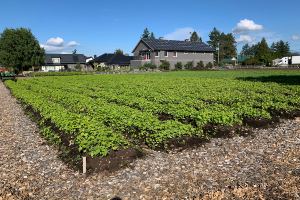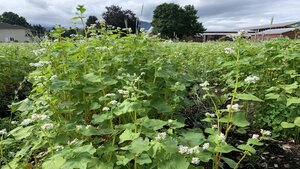Cover cropping when growing garlic is as much a pillar of no-till farming and or gardening as crop rotation and weeding. Feeding the soil is an integral component to any gardener’s toolkit. Whether you are buying a new bag of soil to add to your patio planters, using your own compost or cover cropping with green manure, your objective is all the same: adding matter (in our case, organic matter) to the soil to provide food for the micro-organisms that call your soil home. These fungi and microbial bacteria form a bond with your crops, working for the crop to break down organic matter and minerals and transform them into nutrients that the crop is easily able to take up through their root system. It is a beautiful, symbiotic relationship that needs some care to maintain.
These beautiful cover crops are such a great way of preserving the integrity and the biodiversity of the soil through the winter months or when nothing else is growing. Each crop was planned for and chosen carefully so that it would provide the soil with more nutrients when it leaves then what was already there when it was planted. These crops are an integral part of no till farming practices as they build upon and nourish the delicate ecosystems within the soil.
Being relatively new to cover cropping ourselves but enthusiastic about nourishing our soil, this year we chose a mix of crops that would provide nutrients while replenishing the soil and suppressing weeds but would also be easy to cut and use as green manure in the spring before planting. We chose the following mix of cover crops:

• Winter Field Peas are a good nitrogen fixer. For nitrogen fixation, allow plants to reach the flowering stage.
• Fava Beans are also nitrogen fixers! They add more nitrogen than they take out when used as a green manure. They improve soil texture, help suppress weeds, support microbe’s in the soil food web, attract pollinators with their beautiful flowers, and they are edible.
• Tillage Radish is a good Nitrogen scavenger and a good weed fighter. As a cover crop, the extra-long taproot breaks up and aerates the soil in addition to drawing up nutrients for following crops. When flail cut and raked in just before flowering, its decomposition helps to control soil borne pests, especially cyst and sting nematodes.
These cover crops will add nutrients and organic matter back into the soil, which will leave it better than before and ready for the next crop! In our case, we practice a three-crop rotation. This means that after every garlic harvest – which is our main crop – we will plant a minimum of two successive cover crops before planting garlic again.
After the overwintering cover crop has been terminated by flail mower and left to lay as a green manure in the spring, March / April we seeded the 2nd cover crop which is the following: Oats are ideal for sowing in the spring for erosion control Oats add a lot of carbon and organic matter to soil. They are easily terminated with the flail mower and left to lay as a green manure. Allow two weeks before planting the next crop.

Garlic is a crop that, once it is harvested, best practices are to make sure and remove all the left-over plant matter, unwanted bulbs, leaves and stalks. Do not compost it. It must be removed and destroyed, and not used for compost. The reason for this is that if you have attracted any viruses or garlic specific disease you will just be putting it right back into the soil to multiply and take a stronger hold on the next garlic crop you plant. It is for this very reason that we practice a three-crop rotation. The two crops planted between when the garlic help not only to nurture the soil by feeding the micro-organisms, but also break the disease and/or virus cycle that could potentially be present due to garlic.



